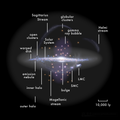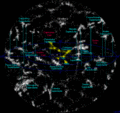| Feature | Diameter | Notes | Sources |
|---|
| (most suitable unit) | (km, with scientific notation) | |
|---|
| Earth | 12,756.2 km
(equatorial) | 1.28×104 | Measurement comprises just the solid part of Earth; there is no agreed upper boundary for Earth's atmosphere.
The geocorona, a layer of UV-luminescent hydrogen atoms, lies at 100,000 km.
The Kármán line, defined as the boundary of space for astronautics, lies at 100 km. | [12] [13] [14] [15] |
| Orbit of the Moon | 768,210 km [b] | 7.68×105 | The average diameter of the orbit of the Moon relative to Earth. | [16] |
| Geospace | 6,363,000–12,663,000 km
(110–210 Earth radii) | 6.36×106–1.27×107 | The space dominated by Earth's magnetic field and its magnetotail, shaped by the solar wind. | [17] |
| Earth's orbit | 299.2 million km [b]
2 AU [c] | 2.99×108 | The average diameter of the orbit of Earth relative to the Sun.
Encompasses the Sun, Mercury and Venus. | [18] |
| Inner Solar System | ~6.54 AU | 9.78×108 | Encompasses the Sun, the inner planets (Mercury, Venus, Earth, Mars) and the asteroid belt.
Cited distance is the 2:1 resonance with Jupiter, which marks the outer limit of the asteroid belt. | [19] [20] [21] |
| Outer Solar System | 60.14 AU | 9.00×109 | Includes the outer planets (Jupiter, Saturn, Uranus, Neptune).
Cited distance is the orbital diameter of Neptune. | [22] |
| Kuiper belt | ~96 AU | 1.44×1010 | Belt of icy objects surrounding the outer Solar System. Encompasses the dwarf planets Pluto, Haumea and Makemake.
Cited distance is the 2:1 resonance with Neptune, generally regarded as the outer edge of the main Kuiper belt. | [23] |
| Heliosphere | 160 AU | 2.39×1010 | Maximum extent of the solar wind and the interplanetary medium. | [24] [25] |
| Scattered disc | 195.3 AU | 2.92×1010 | Region of sparsely scattered icy objects surrounding the Kuiper belt. Encompasses the dwarf planet Eris.
Cited distance is derived by doubling the aphelion of Eris, the farthest known scattered disc object.
As of now, Eris's aphelion marks the farthest known point in the scattered disc. | [26] |
| Oort cloud | 100,000–200,000 AU
0.613–1.23 pc [a] | 1.89×1013–3.80×1013 | Spherical shell of over a trillion (1012) comets. Existence is currently hypothetical, but inferred from the orbits of long-period comets. | [27] |
| Solar System | 1.23 pc | 3.80×1013 | The Sun and its planetary system. Cited diameter is that of the Sun's Hill sphere; the region of its gravitational influence. | [28] |
| Local Interstellar Cloud | 9.2 pc | 2.84×1014 | Interstellar cloud of gas through which the Sun and a number of other stars are currently traveling. | [29] |
| Local Bubble | 2.82–250 pc | 8.70×1013–7.71×1015 | Cavity in the interstellar medium in which the Sun and a number of other stars are currently traveling.
Caused by a past supernova. | [30] [31] |
| Radcliffe wave | 2,700 pc | 8.33×1016 | Gaseous structure running parallel to the Milky Way's arms which contains several regions of star formation. It overlaps with the Gould Belt. | [32] [33] |
| Orion Arm | 6,100 pc
(length) | 1.88×1017 | The spiral arm of the Milky Way Galaxy through which the Sun is currently travelling. | [34] |
| Orbit of the Solar System | 17,200 pc | 5.31×1017 | The average diameter of the orbit of the Solar System relative to the Galactic Center.
The Sun's orbital radius is roughly 8,600 parsecs, or slightly over halfway to the galactic edge.
One orbital period of the Solar System lasts between 225 and 250 million years. | [35] [36] |
| Milky Way Galaxy | 30,000 pc | 9.26×1017 | Earth's home galaxy, composed of 200 billion to 400 billion stars and filled with the interstellar medium. | [37] [38] |
| Milky Way subgroup | 840,500 pc | 2.59×1019 | The Milky Way and those satellite dwarf galaxies gravitationally bound to it.
Examples include the Sagittarius Dwarf, the Ursa Minor Dwarf and the Canis Major Dwarf.
Cited distance is the orbital diameter of the Leo T Dwarf galaxy, the most distant galaxy in the Milky Way subgroup. Currently 59 satellite galaxies are part of the subgroup. | [39] |
| Local Group | 3 Mpc [a] | 9.26×1019 | Group of at least 80 galaxies of which the Milky Way is a part.
Dominated by Andromeda (the largest), the Milky Way and Triangulum; the remainder are dwarf galaxies. | [40] |
| Local Sheet | 7 Mpc | 2.16×1020 | Group of galaxies including the Local Group moving at the same relative velocity towards the Virgo Cluster and away from the Local Void. | [41] [42] |
| Virgo Supercluster | 30 Mpc | 9.26×1020 | The supercluster of which the Local Group is a part.
It comprises roughly 100 galaxy groups and clusters, centred on the Virgo Cluster.
The Local Group is located on the outer edge of the Virgo Supercluster. | [43] [44] |
| Laniakea Supercluster | 160 Mpc | 4.94×1021 | A group connected with the superclusters of which the Local Group is a part.
Comprises roughly 300 to 500 galaxy groups and clusters, centred on the Great Attractor in the Hydra–Centaurus Supercluster. | [45] [46] [47] [48] |
| Pisces–Cetus Supercluster Complex | 330 Mpc | 1×1022 | Galaxy filament that includes the Pisces-Cetus Superclusters, Perseus–Pisces Supercluster, Sculptor Supercluster and associated smaller filamentary chains. | [49] [50] |
| Observable Universe | 28,500 Mpc | 8.79×1023 | At least 2 trillion galaxies in the observable universe, arranged in millions of superclusters, galactic filaments, and voids, creating a foam-like superstructure. | [51] [52] [53] [54] |
| Universe | ≫28,500 Mpc
(possibly infinite) | ≫8.79×1023 | Beyond the observable universe lie the unobservable regions from which no light has yet reached Earth.
No information is available, as light is the fastest travelling medium of information.
However, uniformitarianism argues that the Universe is likely to contain more galaxies in the same foam-like superstructure. | [55] |
|























